Tissue culture in Banana growing

Bananas are one of the most popular fruits on earth. In Uganda and Kenya, the fruit is expansively cultivated for income generation and as a staple food by various local communities. However, the main predicament with banana farming is that they are easily affected by diseases that reduce the yield and lead to sustenance and profit loss to the farmer.
Diseases and pests that affect banana farming include Fusarium Wilt and Sigatoka, weevils and nematodes, and bacterial infections such as bacterial Xanthomonas Wilt (BXW). Additionally, viruses such as banana streak and banana bunchy top disease cause diseases to bananas.
To advance economic development and agriculture, it is important to take on farming technologies that involve providing planting materials that are disease free, mature faster, have better yield, and are safe for human consumption. Tissue culture bananas grow faster and give higher yields as compared to traditional bananas and meet the above-mentioned requirements. Tissue culture technique involves generating plants from stems, leaves or roots in sterilized conditions and can be produced in plentiful quantities.
The distribution of TC bananas plant that are virus indexed is available at nurseries. The technique is also beneficial in helping plants such as bananas that do not generate seeds to reproduce. As earlier mentioned, prevalent viral diseases affect banana farming, and Tissue culture is being used by Kenyan researchers to produce disease resistant materials. The cultured plants are genetically uniform, high-yielding and are free from diseases. This directly improves the economic benefit per unit area of land.
Development of Tissue Culture bananas
After generation under sterile conditions in a laboratory for some weeks, the banana plantlets are hardened in a greenhouse for six weeks. Notably, tissue culture speeds up the multiplication process drastically and up to 2000 healthy bananas can be produced from a single shoot through the method. Conventional bananas, on the other hand, produce ten suckers in 6 months. Also, TC bananas produce fruits in 340 days as compared to 420 days for ordinary bananas. Additionally, the average hectare yield for TC bananas is 30-40 tones that are twice the yield for traditional breeds.
How to grow TC bananas
The farm must have the right conditions for the growth of bananas.
Bananas do well from a sea level of 1800M with a minimum rainfall of 1000m per year which is pertinent during flowering. Farmers in low rainfall areas should ensure that irrigation is done throughout.
Soils should be fertile and well drained to avoid water logging. After these conditions are met, the farmer should get the plantlets from any ATL nursery.
Half a month before planting, pits measuring 3feet x 3feet x3feet should be prepared.
Subsoil and topsoil should be separated, and then 40 kg of well rotten manure should be mixed with the topsoil along with 200g of fertilizer and 15g of the recommended nematicide.
The banana hole should be filled with the mixture, and the plantlets should be planted 30 cm deep in the whole, and the soil should then be firmed. For crops under irrigation, 40 litres should be used initially then 20 litres, three times a week.
Dry mulches should be used to retain moisture while heavy banana stems should be supported to avoid damage. Old diseased leaves should be removed while de-leafing is important to ensure healthy growth.
Harvesting begins after 15-18 months, and a light shiny appearance means that the banana is ready for harvest.
Harvesting should be delicate to avoid bruising of the bananas. The bananas should be temporarily stored in a cool, dry place and should be wrapped in banana leaves or grass to avoid bruising.
If for export, they should be washed using a disinfectant and might require branding.


